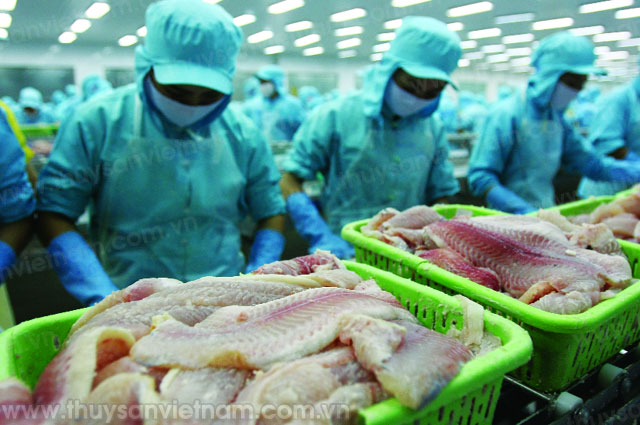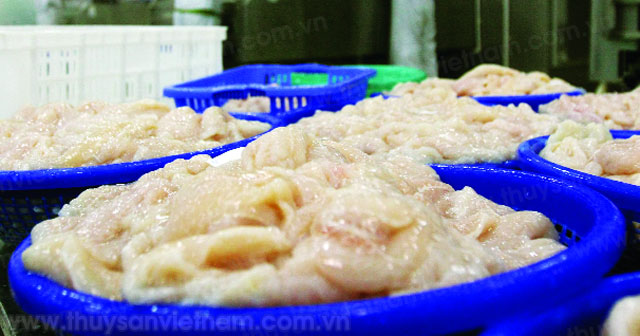Since the first anti-dumping case in 2002, the US has conducted eight anti-dumping investigations on flozen Tra and Basa fillet from Vietnam. Most recently, the US Department of Commerce (DOC) decided to impose an anti-dumping duty 25 – 45 times higher during the 8th administrative review (POR8). This is a dangerous sign for the production, processing and export of Vietnamese Tra fish.
Regulations to be known
Dumping is a phenomenon that the export price of a product from a country to another is lower than a comparable price of a similar product consumed in the exporting country in normal commercial conditions. In nature, dumping in international trade is a price distinction: for the same products or similar products, export prices are lower than domestic prices. This is considered an action aimed at dominating the market and gradually eliminating competitors.
Despite many different viewpoints, the laws of many countries rule that dumping is an unfair trade act. Most of the governments say it is necessary to take actions against dumping to protect domestic production.
The World Trade Organisation (WTO)’s Anti-dumping Agreement has been reached effect and is binding for all member states. This agreement stipulates that anti-dumping measures are only taken in certain circumstances and must meet four requirements: firstly, the product is being dumped; secondly, it is causing material losses or threatening domestic businesses which are producing products similar to the dumped one or causing stagnancy for the establishment of a domestic industry; thirdly, there is a causal relation between dumping and material losses (or threat of material losses) caused by the dumping action and; fourthly, the impacts of dumping must cover a big community.
The affected nation can only apply additional duties besides the normal import duty (anti-dumping duty) on imported goods determined to be dumped. The determination of anti-dumping duties must be based on the dumping margin of concerned products. The dumping margin is the price difference between the export price under review and the ordinary price of the product in the domestic market or the export price to third countries, or the cost of the product.

Vietnamese enterprises must have strategies to diversify products and export markets – Photo: Huy Hung
Under WTO rules, countries are free to develop procedures to determine dumping and apply anti-dumping measures on imports, provided that they do not conflict with WTO agreements and regulations. This is the main reason for many countries to use anti-dumping law as a tool to perform the excessive protection of their domestic markets.
Risks from the US market
|
>> Many experts say that it is time for Vietnamese businesses to have a more serious look at anti-dumping lawsuits which are increasing when Vietnam intergrates further into the world market, thus so as to define difficulties and actively cope with lawsuits from importing markets. |
Flexible applying the WTO provisions on anti-dumping lawsuits, the US has not missed any opportunity to conduct anti-dumping and subsidy investigations against imports from markets, including Vietnam, in order to protect its domestic products. According to the Vietnam Chamber of Commerce and Industry (VCCI), in 1994 – 2010, there were 36 anti-dumping cases related to Vietnam. In particular, the US anti-dumping lawsuit against Vietnamese Tra and Basa in June 2002 was considered the largest so far in terms of size and extent of impact.
In June 2002, the Catfish Farmers of America (CFA) filed a complaint to the US International Trade Committee (ITC) and the DOC against some Vietnamese businesses on a charge that they were dumping their Tra and Basa products in the US market, and proposed an anti-dumping duty of 144 percent if Vietnam is a market economy or 190 percent if Vietnam is a non-market economy. After 39 days since the CFA’s submission, the ITC concluded that Vietnam’s Tra and Basa exports to the US market had threatened and caused material losses for the domestic industry. After more than seven months of investigation, through the various stages (collecting questionnaire, identifying Vietnam’s economy as a market or non-market one, determining the third reference country and collecting relevant evidence…), in late January 2003, the DOC also announced the preliminary results of the investigation that Vietnamese enterprises had dumped tra and basa products in the US and applied three punitive tax rates ranging from 38 to 64 percent. By July 2003, the final conclusions of both the ITC and the DOC confirmed that Vietnamese businesses had dumped their products and fixed anti-dumping duties of between 36.84 and 63.88 percent.
Since 2002, through six annual administrative reviews, as a result of great efforts by the Vietnam Association of Seafood Exporters and Producers (VASEP) and Vietnamese Tra, Basa fish exporters, the anti-dumping duty has been gradually reduced to zero for the majority of Vietnamese defendants.
However, Vietnamese businesses’ joy of enjoying the zero tax did not last long. On March 14, 2013, the DOC announced the final decision of the POR8 for Vietnam’s frozen Tra fillet in the period from August 1, 2010 to July 31, 2011. Accordingly, the tax rate imposed on this product suddenly increased in comparison with that in the POR7, going contrary to the low or zero preliminary rates announced on December 9, 2012.
The DOC’s decision surprised and worried Vietnamese enterprises. Vietnam’s authorized agencies and businesses affirmed that they will sue and follow the lawsuit to the last to win back justice for Vietnamese Tra fish. However, it is unavoidable for Vietnamese businesses to be hurt because to have the case concluded, whether they succeed or fail, they will have to spend much time and money. This was demonstrated in the first anti-dumping lawsuit.
Why sued?
Tra fish, a major export of Vietnam’s seafood industry, is being exported to 142 countries and territories, of which the US market plays a very important role. According to VASEP, in 2012, Vietnam’s Tra fish exports brought back 1.74 billion USD (equivalent to the 2011 figure), of which export turnover to the US hit more than 358 million USD, ccounting for over 20 percent of the country’s total of this product.
When Vietnamese Tra and Basa entered the US with more reasonable prices, it directly impacted this country’s catfish products. In fact, the area of catfish farming in the United States in 2012 fell by half, from about 67,000 ha to over 33,000 ha. Years ago, American catfish breeders repeatedly sought ways to hinder Vietnamese businesses from penetrating into the US market, including forcing the US authorities to create technical barriers and consider Vietnamese Tra, Basa not catfish. Most recently, the US businesses requested the DOC to choose another country, Indonesia or the Philippines, as a basis for calculating prices and taxes, replacing Bangladesh for the Tra, Basa anti-dumping lawsuit in the POR8. This was really a non-transparent deed to find an excuse to prevent the penetration of Vietnamese Tra, Basa into the US and to protect domestic catfish products which have gradually lost the upper hand in their home ground.

It is time for Vietnamese businesses to have a more serious look at anti-dumping lawsuits – Photo: Tran Huy
During the anti-dumping investigations on Vietnamese Tra fish, the US usually selects a third country as the basis for comparison of input cost factors. The selection of such country is very important for considering whether Vietnamese Tra fish are dumped or not. In the POR8, the US abruptly changed Bangladesh with Indonesia (which has its Tra fish processing and production industry far different from that in Vietnam) as the third country, making Vietnam’s Tra fish considered being dumped and imposed a “punitive” duty 25 – 45 times higher than that in the POR7. This was preposterous. However, to clarify the issue, Vietnam must accept to lodge a complaint to the International Trade Court. Time to pursue the lawsuit will surely extend and this is a challenge Vietnamese businesses have to overcome if they don’t want to lose this important market.
Coping with the problem if it is unavoidable
The economic crisis has created opportunities for low-cost products such as seafood, textiles, footwear, rice… to expand their markets but also increased the protection trend of developed countries, including anti-dumping measures. In fact, Vietnam is not the main target of large anti-dumping cases in the world. However, together with increasing export capacity and competitive advantage on price, Vietnam will face more anti-dumping lawsuits. If Vietnamese exporters want to expand markets, there is no other way but to actively prevent and deal with these lawsuits, through studying their nature and procedures as well as taking appropriate response measures when a case occurs.
The first lesson from anti-dumping lawsuits against Vietnam’s Tra fish is that when domestic producers’ competitive edges and market shares decrease, they can use every possible measure to discourage imports. Anti-dumping is one of the measures that the local producers can use. Therefore, US manufacturers have many opportunities to prevent imported goods. Hence, Vietnamese enterprises must have strategies to diversify products and export markets in order to reduce risks and ensure production activities, and should not “put all eggs in one basket”. They should not focus on exporting several commodities with large quantities to one country, because this can be an excuse for countries to commence anti-dumping lawsuits.
In addition, to deal with anti-dumping lawsuits, it is necessary to pay special attention to the transparency of records and accounting books. Through the two shrimp and Tra fish cases, we drew an experience that books and data of many businesses were not clear and transparent, and the investigating agencies did not accept these expenditures, leading to difficulties and disadvantages in investigating the businesses’ dumping margins.
Nguyen Duy Khien, head of the American Market Department under the Ministry of Industry and Trade, pointed out a reason why Vietnamese businesses lost anti-dumping lawsuits. It was that businesses hid information and accounting data and provided unclear archives.
“To actively deal with lawsuits, at first, businesses should examine accounting data and archives clearly and accurately. Information on selling prices and quantities, date, shipping costs and price adjustments must be the most obvious. Information on production costs and others must be separated…” Khien recommended.
|
>> The first lesson from anti-dumping lawsuits against Vietnam’s Tra fish is that when domestic producers’ competitive edges and market shares decrease, they can use every possible measure to discourage imports. Anti-dumping is one of the measures that the local producers can use. |